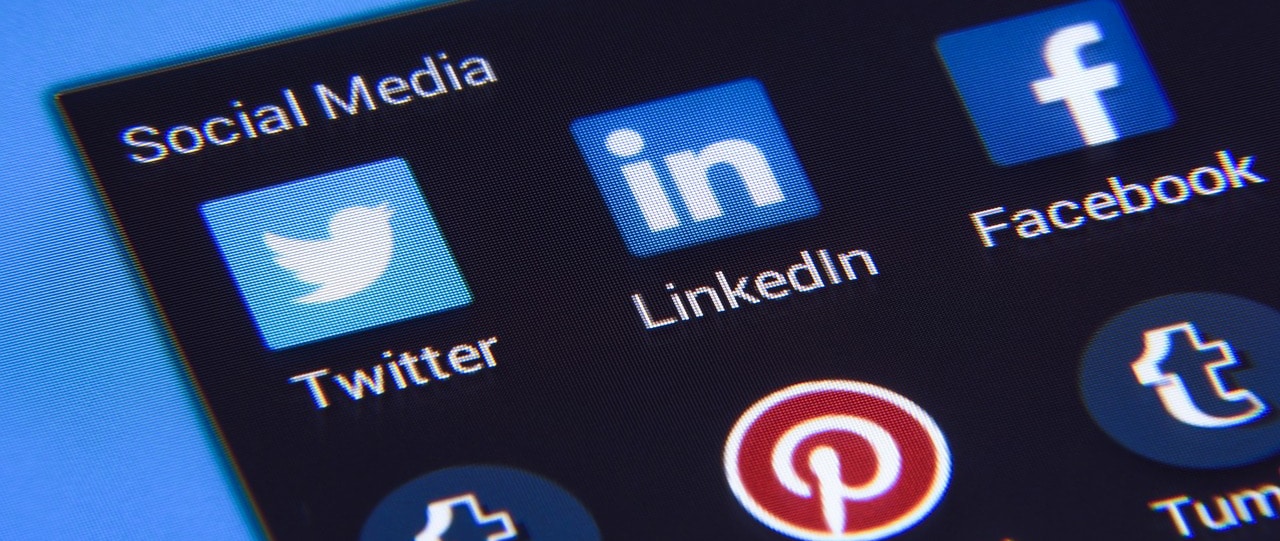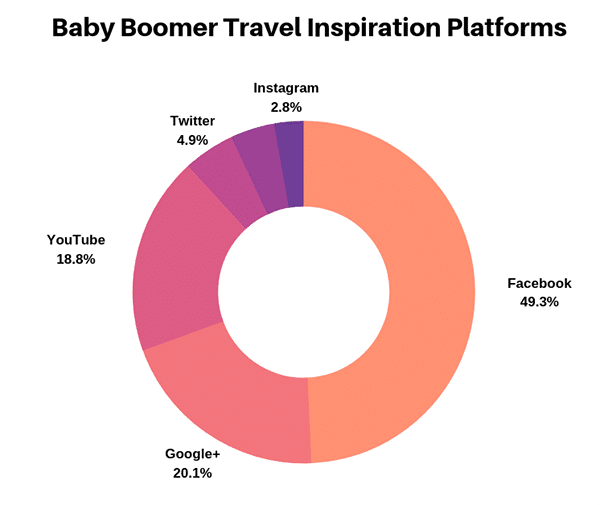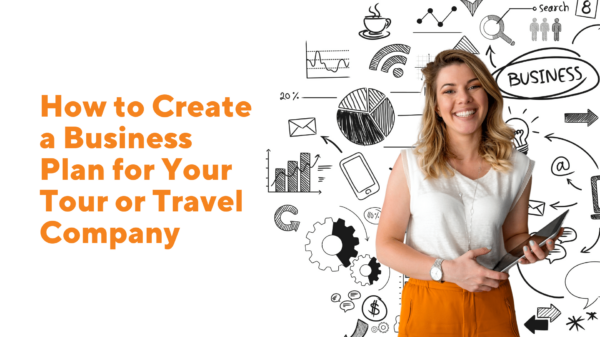
Sure, everyone is using social media – But how can you use it to market your tour or activity business?
We’ve provided a step-by-step guide on how to use social media to market your business along with 5 relevant case studies to prove that it works.
Who Uses Social Media?
According to the AARP 2017 Travel Trends research, 71% of baby boomer travellers use Facebook as an inspiration/planning platform for their next trip.
(Source)
AARP findings also reveal that 22% of Gen Xers and 43% of Millennials use Instagram as a source of inspiration for their next trip.
10 Benefits of Social Media from Hootsuite
- Gain Customer Insights: Different social media tools collect and analyze social media data to help you better understand your customers.
- Increase Brand Awareness: Your online presence makes it easy for customer to find and connect with your brand.
- Run Targeted Ads with Real-time Results: Facebook Ads are inexpensive and effective – They have features that allow you to target based on demographics location, interests, behaviours, and connections.
- Generate Higher Converting Leads: Regularly interacting with your customers and providing great customer service leads to higher conversions and sales.
- Provide rich customers experiences: Social media campaigns, like contests and giveaways, give your customers a rich user experience.
- Increase your search engine rank: The more shares your social media efforts generate, the higher your search engine rank.
- Monitor Competitors: Monitoring your competitors social media allows you to make strategic business decisions based on their efforts.
- Share content faster and easier: Platforms like Twitter help to spread content faster and easier than ever before.
- Geo-target content: Use geo targeting to send out social media campaigns based on a customer’s location.
- Build relationships: Directly answer customer complaints, retweet influencers, and reach out to industry leaders with social media.
Now you know who uses social media and why you should use it – But how can you use social media effectively so that you can market your tour or activity business.
How To Use Social Media
Choose Your Platforms
There are many social media platforms for you to choose from – but choosing the right platform will change how your viewers perceive your message.
It’s important to decide which platform is right for your tour or activity business.
Case Study
Coca-Cola decided to use YouTube to combat the issue of prejudice and “not judging a book by its cover.”
Coca-cola filmed a diverse group of people in a dark room and asked the participants to converse and guess what they looked like – when the lights were turned on everyone was surprised.
Coca-cola chose the perfect platform to communicate their message and harness the emotions of their viewers.
The results were that it worked– the video:
- Generated over 18 million views
- Earned over $30-million in advertising and PR value
- Earned a 35% engagement rate on Facebook and 33% on Twitter
How can you apply this strategy?
Ask yourself:
- What message am I trying to convey?
- Which platform will convey my message the most accurately?
- Which platform is my audience using the most?
- Where can I get the most engagement from my audience?
Check out this article by Buffer Social for a more detailed description on how to choose the right social media platform for you.
Choose a Social Media Manager
Share your social media efforts across multiple platform. Even if you’ve created a YouTube video like Coca-Cola did above, you should tell all your Instagram and Twitter followers to go check it out.
However, managing all your content is a big task – be kind to yourself and use a social media manager to help out with your business efforts.
Case Study
Popular characters Abbi and Llana from the show Broad City are so hilarious and lovable that everyone wants to be friends with them.
Comedy Central wanted to keep Broad City fans engaged between seasons – That’s where they came up with the genius idea to create a web series called “Hack Broad City” where fans can be a “fly on the wall” as the girls chat to each other.
Each episode was shared across multiple social media platforms (like YouTube, Facebook, and Snapchat) and they partnered with Entertainment Weeks, E! Online and Refinery29.
The webisodes generated around 3.2 million views across all platforms, doubling the number of views that season 1 generated.
How can you apply this strategy?
Tour or activity businesses can create a strong online presence by sharing their content across multiple platforms.
There are many social media manager tools to choose from but Hootsuite seems to be the most popular with over 1 million users.
What does Hootsuite do?
- Streamlines all your social media platforms to one dashboard
- Measures your social media ROI
- Maintains your brand integrity by tracking mentions, tags, and messages
- Provides detailed analytics of your efforts
Also check out Social Media Examiner’s 5 Social Media Manager Tools to save time.
Generate Quality Content
Before reaching out to new friends and followers, build quality content for your social media platforms – This way, once your go live, people will have a reason to follow your accounts.
Create videos, come up with contests, and build a stock of beautiful photos.
Case Study
(Source)
Technorati created a high-quality and detailed piece of content labelled the Blogosphere report – An analytical landscape of the blogging world.
Technorati did their research and wrote useful content that many bloggers value – this led to an increase in inbound links from influential sites.
How can you apply this?
- Create high-quality content: Conduct your own primary research and take your time with your content to ensure that it is up to standard.
- Create lots of content: Generate lots of content to keep your friends and followers engaged.
- Create unique content: Create content that is cutting-edge and unique – Go for topics that haven’t been written about before.
- Find and Engage with Influencers: Take the time to breakdown who your target audience is, which social media platforms you can find them on and who influences them – This way you can start to build relationships with the influencers who your audience listens to.
Check out this article to find out more about how to start a blog for your tour or activity business in 6 easy steps.
Case Study
Everyone knows about Starbucks, but there are millions of other coffee shops out there that offer Frappuccinos – So even this big brand has to work hard to stay their customer’s first choice.
Starbucks decided to tackle this situation by starting their Frappuccino Summer of Fun campaign where they partnered with the most influential and creative social media influencers.
Starbucks “identified and partnered with social media Influencers who had minimal overlap with the Frappuccino social media followers to provide reach to new audiences that the brand could reach on its own.”
How can you apply this strategy?
- Define your industry influencers: Try using Upfluence, a tool that identifies, organizes and contacts your industry influencers.
- Engage with influencers: Try offering influencers access to a free service in exchange for a shoutout. Try participating on their social media platforms by following and liking their profiles or commenting on their posts.
- Maintain relationships with influencers: Try promoting your influencers content with Right Relevene Pro, a Hootsuite app that allow you to find and share relevant content from your influencers.
- Engage With Friends and Followers: Engage with your friends and followers instead of just promoting your tour or activity business. By engaging with your customers, they are going to feel as if you really care (which you do of course)
Rezgo recommends the following tools for engagement:
- Disqus.com – Disqus is a shared commenting system used by many blogs. It allows you to post your comments to Twitter and share them on Facebook from the same profile.
- Gravatar.com – Gravatar stands for “Globally Recognized Avatar” and is used to associate a profile image with your email address. Gravatar is used on many blog sites to personalize comments left by visitors. The benefit of using a Gravatar is that you can brand your comments as your own.
- Create a Profile Page – If you have not already done so, create a page on your website about you. This is not an online resume, but rather a place for you to talk a little bit about yourself, what you do, and why you love to do it.
Case Study
You can see that Southwest understands the importance of engaging with customers when they started the Listening Center – A “collaborative workspace where the airline can, in real time, listen to, engage with, and analyze social conversation among customers, news media, and employees.”
How can you apply this strategy?
A big company like SWA has a large amount of resources to tap into, but as a small tour or activity business you can still make efforts to pay close attention to your customers.
- Keep track of all the bad things that your customers are saying so that you can participate in the discussion and solve their problem.
- Keep track of all the good things that customers are saying and thank them for their feedback.
Check out the Social Media Examiner’s 6 Social Media Monitoring Tools for keeping track of your brand.






